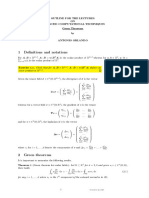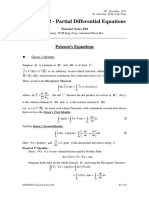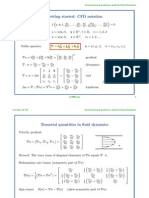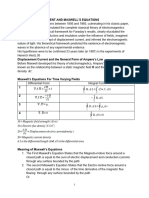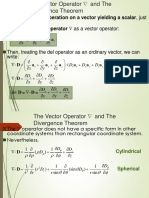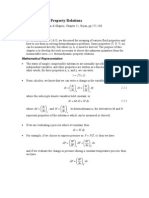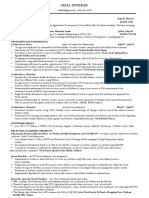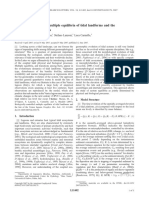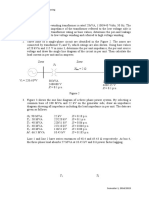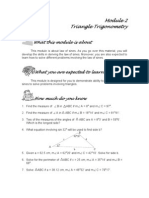Gradient of A Matrix Matrix Multiplication
Gradient of A Matrix Matrix Multiplication
Uploaded by
Jason StanleyCopyright:
Available Formats
Gradient of A Matrix Matrix Multiplication
Gradient of A Matrix Matrix Multiplication
Uploaded by
Jason StanleyOriginal Title
Copyright
Available Formats
Share this document
Did you find this document useful?
Is this content inappropriate?
Copyright:
Available Formats
Gradient of A Matrix Matrix Multiplication
Gradient of A Matrix Matrix Multiplication
Uploaded by
Jason StanleyCopyright:
Available Formats
Edward Hu Blog About
Gradient of a Matrix Matrix multiplication
JULY 28, 2018 - 3 MINUTE READ - MACHINE LEARNING BACKPROPAGATION MATRIX CALCULUS
This is just matrix multiplication.
It’s good to understand how to derive gradients for your neural network. It gets a little hairy when you have
matrix matrix multiplication, such as W X + b . When I was reviewing Backpropagation in CS231n, they
handwaved over this derivation of the loss function L in respect to the weights matrix W :
∂L ∂L ∂D
=
∂W ∂D ∂W
∂L ∂L
T
= X
∂W ∂D
Let:
X = (m, n) input matrix with m features and n samples
W = (H , m) weight matrix with H neurons
D = WX
(H , n) matrix
L = f (D)
scalar value, f is arbitrary loss function
Note that others may use D = XW where X ’s rows are samples and columns are feature dimensions. That’s
ok, you can follow this math and switch the indices and nd the result to be identical.
The canonical neuron is Relu(D + b), but to make things simpler we’ll ignore the nonlinearity and bias and
say the L takes in D instead of Relu(D + b). We want to nd the gradient of L with respect to W to do
gradient descent.
We want to nd , so let’s start by looking at a speci c weight Wdc . This way we can think more easily
∂L
∂W
about the gradient of L for a single weight and extrapolate for all weights W .
∂L ∂L ∂ D ij
= ∑
∂ W dc ∂ D ij ∂ W dc
i,j
∂Dij
Let’s look more closely at the partial of D ij with respect to Wdc . We know that = 0 if i ≠ d because
∂Wdc
D ij is the dot product of row i of W and column j of X . This means the summation can be simpli ed by only
∂Dij
looking at cases where ≠ 0 , which is when i = d .
∂Wdc
∂L ∂ D ij ∂L ∂ D dj
∑ = ∑
∂ D ij ∂ W dc ∂ D dj ∂ W dc
i,j j
∂Ddj
Finally, what is ?
∂Wdc
D dj = ∑ W dk X kj
k=1
q q
∂ D dj ∂ ∂
= ∑ W dk X kj = ∑ W dk X kj
∂ W dc ∂ W dc ∂ W dc
k=1 k=1
∂ D dj
∴ = X cj
∂ W dc
So to put it all together, we have:
∂L ∂L
= ∑ X cj
∂ W dc ∂ D dj
j
Now how can we simplify this? Well, one quick way is see that the sum over j is doing a dot product on with
row d and column c if we transpose X cj to X jc
T
.
∂L ∂L
T
= ∑ X
jc
∂ W dc ∂ D dj
j
Now we want this for all weights in W , which means we can generalize this to:
∂L ∂L
T
= X
∂W ∂D
1 Comment edwardshu 🔒 Disqus' Privacy Policy Jason Stanley
Recommend 1 t Tweet f Share Sort by Best
Join the discussion…
Michael Heinzer • 4 months ago
There is a slightly imprecise notation whenever you sum up to q, as q is never defined. The q term should probably be replaced by m. I would recommend adding the limits of your sum everywhere to make your post more
clear.
△ ▽ • Reply • Share ›
✉ Subscribe d Add Disqus to your siteAdd DisqusAdd ⚠ Do Not Sell My Data
You might also like
- Arihant NCERT Notes India & World Geography - Nihit KishoreDocument369 pagesArihant NCERT Notes India & World Geography - Nihit Kishoreakpatel191183% (12)
- Api RP 2SM-2014 (2020)Document116 pagesApi RP 2SM-2014 (2020)HASEEB FAYYAZ ABBASINo ratings yet
- Solutions For Chapter 2Document6 pagesSolutions For Chapter 2faizee1985No ratings yet
- Green TheoremsDocument4 pagesGreen TheoremsantonioNo ratings yet
- FF Elecreomagnetics1 ZDDocument11 pagesFF Elecreomagnetics1 ZDNərgiz QasımovaNo ratings yet
- Electric Potential of A Charge Distribution.: Today's AgendaDocument30 pagesElectric Potential of A Charge Distribution.: Today's AgendaÖzgür BOZANo ratings yet
- Lecture 10 - Transmission Lines: X X y yDocument8 pagesLecture 10 - Transmission Lines: X X y ysamer saeedNo ratings yet
- Gradient NotesDocument5 pagesGradient Notesganor44300No ratings yet
- MECN3036 FormulaSheetDocument2 pagesMECN3036 FormulaSheetMuaaz MoosaNo ratings yet
- Equation of Continuity (Conservation of Charge) :: DT DQDocument3 pagesEquation of Continuity (Conservation of Charge) :: DT DQDevkriti SharmaNo ratings yet
- ThermodynamicsDocument2 pagesThermodynamicsrgcsm88No ratings yet
- HW5 SolDocument3 pagesHW5 SoloppipxNo ratings yet
- Porous Wall MembranasDocument5 pagesPorous Wall MembranasRoberto WilsonNo ratings yet
- Total Differential, Rates of Change and Small ChangesDocument6 pagesTotal Differential, Rates of Change and Small ChangesChainarong TaepanichNo ratings yet
- Arfken MMCH 9 S 7 e 4Document4 pagesArfken MMCH 9 S 7 e 4QuratulainNo ratings yet
- Classification of Equations - CharacteristicsDocument5 pagesClassification of Equations - CharacteristicsAmit JhaNo ratings yet
- ElectromagniticDocument13 pagesElectromagniticsanjay sNo ratings yet
- Integral Theorems: 1 Integral of The GradientDocument7 pagesIntegral Theorems: 1 Integral of The GradientCaio CamposNo ratings yet
- EMT10 NewDocument12 pagesEMT10 NewzcaptNo ratings yet
- Transient Waves On Transmission LinesDocument21 pagesTransient Waves On Transmission Linesatul206No ratings yet
- Vector Space PDFDocument26 pagesVector Space PDFShashi KumarNo ratings yet
- Dash of Maxwells Chapter 2Document13 pagesDash of Maxwells Chapter 2조성철No ratings yet
- Electromagnetism Basics - Formulas, Solutions, ApplicationsDocument4 pagesElectromagnetism Basics - Formulas, Solutions, Applicationscarlos120munroNo ratings yet
- MATH4052 - Partial Differential EquationsDocument9 pagesMATH4052 - Partial Differential EquationsJohn ChanNo ratings yet
- ECU103 Lecture 06Document30 pagesECU103 Lecture 06sanicyril7No ratings yet
- 0.1 Derivation of Unsteady Bernoulli's Equation: 2.016 HydrodynamicsDocument1 page0.1 Derivation of Unsteady Bernoulli's Equation: 2.016 HydrodynamicsIhab OmarNo ratings yet
- Vector Operators and Plane Curves: Radu MiculescuDocument47 pagesVector Operators and Plane Curves: Radu Miculescuprica_adrianNo ratings yet
- Transmission Lines: 1 A Lossless Transmission LineDocument20 pagesTransmission Lines: 1 A Lossless Transmission LineChandan ChoudharyNo ratings yet
- 1---Mixed-Finite-Elements-for-_2017_Stable-Numerical-Schemes-for-Fluids--StrDocument44 pages1---Mixed-Finite-Elements-for-_2017_Stable-Numerical-Schemes-for-Fluids--StrbasukumbarNo ratings yet
- CIVL3612/9612 Fluid Mechanics: Equation SheetDocument3 pagesCIVL3612/9612 Fluid Mechanics: Equation Sheetvincent vivekNo ratings yet
- Lec 10 Example PiecewiseGDE 1D Bar HDocument3 pagesLec 10 Example PiecewiseGDE 1D Bar Hyijewen662No ratings yet
- Vector CalculusDocument17 pagesVector CalculusradhjasraNo ratings yet
- m341 10 Lecture07 Mass Conserv DiffDocument8 pagesm341 10 Lecture07 Mass Conserv DiffDeepak SinghalNo ratings yet
- Maxwell EquationDocument2 pagesMaxwell Equation黃士軒No ratings yet
- Linear Quadratic GradientsDocument3 pagesLinear Quadratic GradientsSuryaTeja MasapoguNo ratings yet
- Open Systems: Chemical Potential: 0=Sdt −Vdp+Ndμ→ Ndμ=Vdp−Sdt → Dμ=~V Dp−~S DtDocument5 pagesOpen Systems: Chemical Potential: 0=Sdt −Vdp+Ndμ→ Ndμ=Vdp−Sdt → Dμ=~V Dp−~S DtluciaNo ratings yet
- KCL KVL 2Document3 pagesKCL KVL 2son gokuNo ratings yet
- Lecture # 02 Goverening Equations and Its DiscritizationDocument55 pagesLecture # 02 Goverening Equations and Its Discritizationmaheshj90No ratings yet
- EMFIELDS ASSIGNMENT 2Document5 pagesEMFIELDS ASSIGNMENT 2Reagan TorbiNo ratings yet
- Equations of Motion, Momentum and Energy For Deformable SolidsDocument11 pagesEquations of Motion, Momentum and Energy For Deformable SolidsAditya AgrawalNo ratings yet
- Aerodynamic 5Document15 pagesAerodynamic 5حسين نبيل محمدNo ratings yet
- E·dS= B · dS = 0 E · dl = − B · dS J + ε B·dl= J + ε: Fundamental constants Unit conversionsDocument4 pagesE·dS= B · dS = 0 E · dl = − B · dS J + ε B·dl= J + ε: Fundamental constants Unit conversionsbarryNo ratings yet
- Timoshenko BeamDocument5 pagesTimoshenko BeamNishal CalebNo ratings yet
- Maxwell's Equations-2-9-2022Document7 pagesMaxwell's Equations-2-9-2022abstudio0049No ratings yet
- Guass Div THDocument5 pagesGuass Div THarpit sharmaNo ratings yet
- Divergence Is An Operation On A Vector Yielding A Scalar, Just Like The Dot Product. We Define The Del Operator As A Vector OperatorDocument23 pagesDivergence Is An Operation On A Vector Yielding A Scalar, Just Like The Dot Product. We Define The Del Operator As A Vector OperatorKybs nyhuNo ratings yet
- Motion and DeformationDocument3 pagesMotion and DeformationPatrick Joseph RoblesNo ratings yet
- Unit 3: Analytic FunctionsDocument20 pagesUnit 3: Analytic FunctionsKAVIN PARITHI.SNo ratings yet
- MA111 Lec7 D3D4Document20 pagesMA111 Lec7 D3D4pahnhnykNo ratings yet
- 1.2 Differential Calculus 1.2.1 "Ordinary" Derivatives: DF DF DX DXDocument7 pages1.2 Differential Calculus 1.2.1 "Ordinary" Derivatives: DF DF DX DXnahom teferaNo ratings yet
- Lagrangian PropertiesDocument3 pagesLagrangian PropertiesPipíNo ratings yet
- Thermodynamic Property Relations: Dy y Z DX X Z DZDocument49 pagesThermodynamic Property Relations: Dy y Z DX X Z DZmsgkevNo ratings yet
- 1 技巧Document3 pages1 技巧lyr13903570599No ratings yet
- LECTURE2Document7 pagesLECTURE2kemangpitsoNo ratings yet
- sol5Document7 pagessol5kumardeepkdmNo ratings yet
- Theorie 437253 abWS2017-18 (Engl)Document174 pagesTheorie 437253 abWS2017-18 (Engl)neumair.evaNo ratings yet
- 6 Technical ResultsDocument3 pages6 Technical ResultsAdrian Marin JimenezNo ratings yet
- 1 Thermodynamic Relations: 1.1 Relations For Energy PropertiesDocument24 pages1 Thermodynamic Relations: 1.1 Relations For Energy PropertiesSarthak100% (2)
- Summary Chapter2Document4 pagesSummary Chapter2blalllNo ratings yet
- Example-Water Flow in A PipeDocument13 pagesExample-Water Flow in A PipecristinelbNo ratings yet
- Green's Function Estimates for Lattice Schrödinger Operators and ApplicationsFrom EverandGreen's Function Estimates for Lattice Schrödinger Operators and ApplicationsNo ratings yet
- Sae ApplicationDocument2 pagesSae ApplicationJason StanleyNo ratings yet
- Topic#3.Scalars, Vectors and TensorsDocument64 pagesTopic#3.Scalars, Vectors and TensorsJason StanleyNo ratings yet
- PARAFAC. Tutorial and Applications: ElsevierDocument23 pagesPARAFAC. Tutorial and Applications: ElsevierJason StanleyNo ratings yet
- Sejal Divekar Resume1Document2 pagesSejal Divekar Resume1Jason StanleyNo ratings yet
- Cublas LibraryDocument254 pagesCublas LibraryJason StanleyNo ratings yet
- Quadratic Forms and Convexity: Eivind EriksenDocument22 pagesQuadratic Forms and Convexity: Eivind EriksenJason StanleyNo ratings yet
- Marani - Et - Al 2007Document5 pagesMarani - Et - Al 2007Jason StanleyNo ratings yet
- 1 s2.0 S1877050917307858 MainDocument10 pages1 s2.0 S1877050917307858 MainJason StanleyNo ratings yet
- Numerical Methods 2Document281 pagesNumerical Methods 2Jason StanleyNo ratings yet
- Murray, Knaapen 2008Document18 pagesMurray, Knaapen 2008Jason StanleyNo ratings yet
- Efficient Parallel Non-Negative Least Squares On Multi-Core ArchitecturesDocument16 pagesEfficient Parallel Non-Negative Least Squares On Multi-Core ArchitecturesJason StanleyNo ratings yet
- BLVS (Bounded - variableLSucb)Document13 pagesBLVS (Bounded - variableLSucb)Jason StanleyNo ratings yet
- Marani Et Al. 2013Document5 pagesMarani Et Al. 2013Jason StanleyNo ratings yet
- "List of Possible Topics For OE545 ProjectDocument1 page"List of Possible Topics For OE545 ProjectJason StanleyNo ratings yet
- Prediction of Warship Manoeuvring Coefficients Using CFD: C. Oldfield, M. Moradi Larmaei, A. KendrickDocument17 pagesPrediction of Warship Manoeuvring Coefficients Using CFD: C. Oldfield, M. Moradi Larmaei, A. KendrickJason StanleyNo ratings yet
- OE5450: Numerical Techniques in Ocean Hydrodynamics: Implementation of FEM On A Rectangular DomainDocument15 pagesOE5450: Numerical Techniques in Ocean Hydrodynamics: Implementation of FEM On A Rectangular DomainJason StanleyNo ratings yet
- OE4020 Assignment - 1: Jason Stanley.S Na15b021Document1 pageOE4020 Assignment - 1: Jason Stanley.S Na15b021Jason StanleyNo ratings yet
- Fem Shape FunctionDocument11 pagesFem Shape FunctionJason StanleyNo ratings yet
- 102.20-N1 (1109) SolutionDocument140 pages102.20-N1 (1109) Solutionlist16947No ratings yet
- 06 WDM教學Document26 pages06 WDM教學Wei LiaoNo ratings yet
- Nastran Element Quality ChecksDocument2 pagesNastran Element Quality ChecksAnonymous oCOJwWNo ratings yet
- Review of Train Wheel Fatigue LifeDocument15 pagesReview of Train Wheel Fatigue Lifeabdurhman suleimanNo ratings yet
- 2005KIWYMIC IndividualDocument4 pages2005KIWYMIC IndividualJLNo ratings yet
- Tutorial Chapter 2Document5 pagesTutorial Chapter 2Naasir SheekeyeNo ratings yet
- Rev01 - QRATE Scanner 3300 Hardware User ManualDocument92 pagesRev01 - QRATE Scanner 3300 Hardware User ManualMiguel I. Roman BarreraNo ratings yet
- Logical ReasoningDocument37 pagesLogical ReasoningPooja SharmaNo ratings yet
- Triangle Trigonometry: What This Module Is AboutDocument25 pagesTriangle Trigonometry: What This Module Is AboutisayblankNo ratings yet
- Simulation of Indirect Field-Oriented Induction Motor Drive SystemDocument12 pagesSimulation of Indirect Field-Oriented Induction Motor Drive SystemThinseepNo ratings yet
- Tugas Bahasa InggrisDocument24 pagesTugas Bahasa InggrisKenanNo ratings yet
- Jahn Teller Theorm 5th ChemDocument10 pagesJahn Teller Theorm 5th ChemMuhammad ArhamNo ratings yet
- Survey ProceduresDocument52 pagesSurvey ProceduresnainaNo ratings yet
- dll-math-8-third-quarter_OKDocument26 pagesdll-math-8-third-quarter_OKNodelyn ReyesNo ratings yet
- (GIS - 23) Lecture 2 - GeoreferncingDocument29 pages(GIS - 23) Lecture 2 - GeoreferncingPhilip Wagih100% (1)
- P&IDDocument34 pagesP&IDAz Zahra Assyifa Ushwah100% (1)
- BURGMANN Manual 15.4Document153 pagesBURGMANN Manual 15.4EmmanuelNo ratings yet
- Max9924 Max9927Document23 pagesMax9924 Max9927someone elseNo ratings yet
- ME 2110 D The Georgia Tech Experience Final ReportDocument38 pagesME 2110 D The Georgia Tech Experience Final ReportCampbell PattersonNo ratings yet
- Questions MetDocument8 pagesQuestions MetAsim AnandNo ratings yet
- IO Interfaces-Chp 6Document45 pagesIO Interfaces-Chp 6Sahil NagraNo ratings yet
- Air, Atmospheric Pressure and WindsDocument42 pagesAir, Atmospheric Pressure and WindsVishnu Prasad100% (1)
- G8 Mathematics Syllabus Sy 2022 2023Document12 pagesG8 Mathematics Syllabus Sy 2022 2023AARON ZUELANo ratings yet
- Lecture Note On Mat 313 Optimization Theory Ii 3unitsDocument12 pagesLecture Note On Mat 313 Optimization Theory Ii 3unitsAdetola OlamideNo ratings yet
- Assignment 3 - Semester 1 - 2022Document11 pagesAssignment 3 - Semester 1 - 2022Ziphelele VilakaziNo ratings yet
- MCQ Fso Iii, Iv, V PDFDocument4 pagesMCQ Fso Iii, Iv, V PDFPETRO HODNo ratings yet
- Trading The Connors Windows StrategyDocument11 pagesTrading The Connors Windows StrategyJoe DNo ratings yet
- Beam Pre StressDocument55 pagesBeam Pre StresssurangaNo ratings yet



